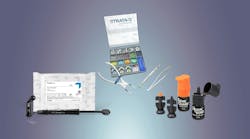Ecosite One
Ecosite One is an innovative one-shade composite for highly esthetic posterior restorations that features easy handling, 3 mm depth of cure, and rapid polymerization with only a 10-second photocure. This material, available in syringe or unit-dose, is color stable and highly polishable due to its proprietary NC1 (nonclustering) technology. This technology uses silanization of the individual fillers to yield a homogeneous distribution, leading to fast, glossy polishing. But perhaps the best feature is Ecosite’s Push-and-Flow effect that provides excellent cavity wall adaptation and sculptability. This effect is unique, as the material is somewhat firm when placed and becomes more pliable as you work it into the restorative area.
More "I have it—you want it!":
- SimpliShade, GINGICaine, and Adhese Universal DC
- Knockout Trays, Paladex, Freestyle Pro Handpiece
- Bio-LCB, AutoFlosser, Soft Tissue Trimmer
There are multiple indications for this material, including: class I, II, V, and cuspal restorations; core buildups; extended fissure sealing; and restorations in primary dentition. Ecosite One is an extension of the Ecosite Elements suite of materials that provide a master class selection of shades segmented into Pure (A1, A2, A3, A3.5, B1, BL1), which are designed as a universal restorative for both anterior and posterior dentition; Layer (EB, EL, EM, ED), which complement the Pure shades for enhanced shade matching; and Highlight (Inc, OA2, W, B) for customization. All Ecosite materials feature Push-and-Flow handling, and are must-consider composites to maximize your esthetic restorative outcomes.
Strata-G Sectional Matrix System
Creating a tight contact to the adjacent tooth was easy with alloy restorations due to the expansion of the material. This is not the case with composite restorations, and therefore one must have a reliable, easy-to-use matrix system to ensure proper contact. Strata-G provides tight contact with rings that will not slip, wedges that will stay in place, and bands that help create ideal marginal ridges. Much like the original Composi-Tight 3D Fusion system, Strata-G comes in a well-organized box that easily fits into a drawer, and compartments are labeled to make reordering easy. All the instruments from Composi-Tight 3D Fusion can be used with Strata-G.
The secret of the Strata-G rings is that they are made of drawn-wire nickel titanium plus PEEK to produce a constant, strong separation pressure for a great period of time. Strata-G rings, bands, and wedges are designed as a system to provide a 270-degree seal for controlling unwanted composite flash. Equally important, the rings will not pop off unexpectedly, and they even have a ring designed for those wide class II preparations that wrap around to the buccal and/or lingual. These rings, aptly called wide rings, make it easy to do a wide prep using their color-coded, nonstick bands that shape and guide the development of an optimal marginal ridge. They are made of incredibly thin (0.0016”) dead soft material, and pediatric sizes are available. You will have clear visibility and create natural emergence profiles in the cervical area. Strata-G provides the ultimate strategy for successful class II restorations!
Rodin Bond
Rodin Bond is a unique two-bottle bonding system (also in unit-dose) that consists of both a glass-filled nanohybrid adhesive bonding agent—Rodin Bond—and a dual-function desensitizer and primer called SensiGuard. What makes this unique is that it is designed for 3D printing, offering superior bond strength to 3D printed applications as well as conventional direct restorative procedures. When used in combination, the system provides for both bonding and the sealing of the dentin tubules, thus preventing sensitivity and greatly reducing the formation of secondary decay. SensiGuard also increases the shear bond strength of both direct and indirect surfaces. Rodin Bond deeply penetrates the dentin tubules, creating bond strengths that surpass unfilled adhesive resins.
The bottles have a clever flip-top designed to deposit a single drop during single-handed use, thus avoiding waste, while their unit-dose packaging prevents air and moisture contamination of the adhesive resin. This system can be used with light-cured, self-cured, and dual-cured resins on both direct and indirect restorative substrates such as metal, ceramic, zirconia, and 3D printed restorations. This is a great system for the ultrasensitive patient whereby you want to protect against postoperative sensitivity by sealing the dentinal tubules, while ensuring adhesive compatibility with a wide variety of direct and indirect materials.
Editor's note: This article appeared in the February 2024 print edition of Dental Economics magazine. Dentists in North America are eligible for a complimentary subscription. Sign up here.
Howard S. Glazer, DDS, FAGD, is a fellow of the Academy of General Dentistry, American College of Dentists, International College of Dentists, American Society for Dental Aesthetics, American Academy of Forensic Sciences, and a diplomate of the American Board of Aesthetic Dentistry. He is an attending dentist at the Englewood Hospital in Englewood, New Jersey, and the deputy chief forensic dental consultant to the Office of Chief Medical Examiner, City of New York. For the past several years, Dr. Glazer was named one of the top dentists in New Jersey by New Jersey Monthly, 201 Magazine, and Bergen Magazine. He lectures nationally and internationally on the subjects of dental materials, cosmetic dentistry, forensic dentistry, and patient management. Additionally, Dr. Glazer is a frequent author of dental articles and has been published worldwide. For 14 years he wrote a column, “What’s Hot and What’s Getting Hotter!” in AGD Impact. He currently writes the column “I have it—You want it!” in Dental Economics. Dr. Glazer maintains a general practice in Fort Lee, New Jersey.






